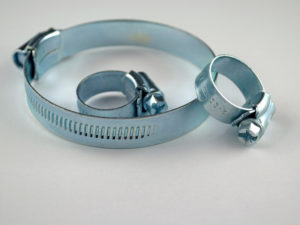 Most people hope nothing ever goes wrong with their automobile. But chances are good that you’ll need to have repairs performed sometime within the next few years. And according to Murphy’s Law, these mechanical problems will inevitably occur at the worst possible time. If you’re new to DIY auto repairs, then a good place to start is learning how to install and replace auto hose clamps.
Most people hope nothing ever goes wrong with their automobile. But chances are good that you’ll need to have repairs performed sometime within the next few years. And according to Murphy’s Law, these mechanical problems will inevitably occur at the worst possible time. If you’re new to DIY auto repairs, then a good place to start is learning how to install and replace auto hose clamps.
Stainless steel clamps are often used in automotive systems to secure lines like your radiator hoses. But over time, these clamps can become vulnerable or even corroded. These hoses ensure your radiator is able to keep a consistently high internal pressure, and if these standard or embossed clamps stop working the way they should, it can cause your car to overheat. At some point, you may need to replace your existing embossed hose clamps with brand new ones to keep your car in tip-top shape.
But how do you replace these auto hose clamps? Below, we’ve outlined three easy DIY steps for hose clamp replacement under the hood.
- Cool Down
The first step in hose clamp replacement is to let your engine (and therefore, your radiator) cool down. If you don’t let the engine sit for at least an hour before starting this process, you may suffer severe burns. You’ll also want to drain the coolant from your engine into a drip pan. Make sure to dispose of this properly, as it’s an environmentally hazardous and toxic material. - Measure and Remove
Secondly, you’ll want to measure the length of both your clamps and the hoses they secure. You should consult your vehicle manual to double-check this measurement. Eyeballing these measurements is never a good idea, as even a small difference can make a big impact. Once you have these measurements, remove the clamps with pliers or a screwdriver and use a knife to cut the end of your hose by one inch, lengthwise, and wiggle it off the fitting. Do not pull the hose off, as this may result in necessary replacement of the entire heater core. - Replace
Lastly, you’ll want to remove any debris from the fittings. Be careful not to use water. Install a new hose into the fitting. When choosing your clamp, keep in mind that embossed hose clamps are less likely to corrode or snap. They’re a bit more expensive, but you get what you pay for. They’re much more reliable than your no-frills clamp. Secure your clamp with a screwdriver or pliers, then make sure the fitting is snug but not too tight. Refill your coolant levels to finish up. Don’t forget to test for leaks or drips.
For a variety of DIY tasks, embossed hose clamps can help keep your home and car safe for you and your family. To find out more about these and the other types of hose clamps we carry, contact Hose Clamp Kings today.

